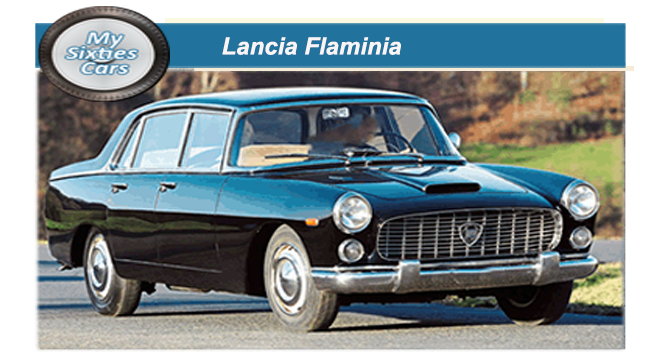
The Flaminia was brought in by Lancia late in 1956, in time for the 1957 model year, to cover the gap in their luxury car sector so adequately filled by the Aurelia.
Lancia's 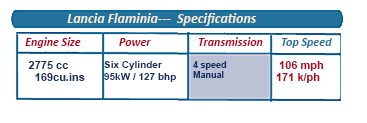 aristocratic Flaminia (another Roman road name) appeared two years before its predecessor was discontinued.
aristocratic Flaminia (another Roman road name) appeared two years before its predecessor was discontinued.
In appearance, the Lancia Flaminia was very different from the rotund Aurelia, as Pininfarina chose to style the car with more angular lines.
At the rear, there were even small fins, giving the Italian saloon something of an American look.
With the Aurelia engine unable to be developed any further, Lancia put a new 2458cc (150 cu in) V6 unit in the Flaminia, as well as updated wishbone and coil-spring front suspension.
The Aurel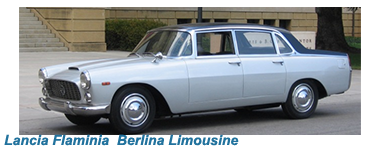 ia remained in production with no significant changes until 1959, when a range of new Flaminias appeared, all with sporting pretensions.
ia remained in production with no significant changes until 1959, when a range of new Flaminias appeared, all with sporting pretensions.
A very elegant coupe (based on the Pininfarina Floride II show car) was joined by the even more beautiful Flaminia GT convertible.
These models sat on a substantially shortened wheelbase and efficient use of quad headlights to give a purposeful front aspect.
In production up until the beginning of the Seventies, Lancia followed their now tried and tested formula of producing the sedan version of the Flaminia in their Turin plant and "farming out" coupé and cabriolet production to several of Italy’s most prestigious coachbuilders, among them Pininfarina and Zagato.
![]()
The new Flaminia series, powered by a revamped version of Lancia's V-6 this time a 2458-cc, 150 cubic inch engine, was capable of generating 99 horsepower, matched up to a four-speed gearbox.
From 1963, all Flaminia engines were uprated with a 2775cc (169 cu in) V6 engine — the coupes and convertibles were tuned to produce more power than the saloon. Other sig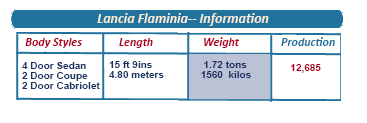 nificant developments in motoring technology that Lancia fitted on the Flaminia were an all-new universal wishbone suspension and Dunlop inboard rear brakes.
The " standard" four-door sedan featured a Pininfarina created " ready for the Sixties" box-shaped design, a distinct departure from the Aurelia, which was in the rounded Fifties style.
Particular features of the Flaminia's pillarless body included a mesh-type
V-shaped grille, hood scoop, and a wraparound windshield.
The Flami
nificant developments in motoring technology that Lancia fitted on the Flaminia were an all-new universal wishbone suspension and Dunlop inboard rear brakes.
The " standard" four-door sedan featured a Pininfarina created " ready for the Sixties" box-shaped design, a distinct departure from the Aurelia, which was in the rounded Fifties style.
Particular features of the Flaminia's pillarless body included a mesh-type
V-shaped grille, hood scoop, and a wraparound windshield.
The Flami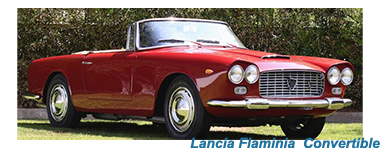 nia was fitted to the highest levels of comfort and contained all of the latest technological developments to heighten the driving experience. Standard features included a tachometer and odometer mounted on the car's instrument panel.
The sedan's interior layout was designed to allow the front seat back to be folded to a horizontal position, while the driver could control the position of rear quarter vent windows.
In addition, each window on the Flaminia sedan was designed to have its own frame so the sides would not be completely open when the windows were down.
nia was fitted to the highest levels of comfort and contained all of the latest technological developments to heighten the driving experience. Standard features included a tachometer and odometer mounted on the car's instrument panel.
The sedan's interior layout was designed to allow the front seat back to be folded to a horizontal position, while the driver could control the position of rear quarter vent windows.
In addition, each window on the Flaminia sedan was designed to have its own frame so the sides would not be completely open when the windows were down.
![]()
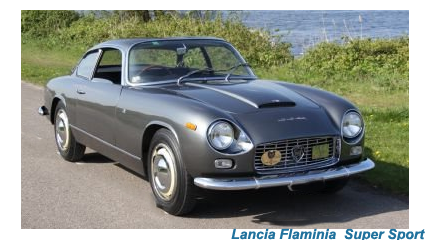 e several different variants of Flaminia, but one of the best-looking ones was the Flaminia convertible, with design by Touring of Milan.
There were even four "presidential" stretched limousine version of the Flaminia produced by Pininfarina and used by the Italian Government on state occasions.
The aluminium-bodied Zagato fastback was considered the most stylish of all the Flaminia variations, with its deeply recessed headlamps behind clear lenses offsetting the ultra-modern grille appearance.
Although demand for the Flaminia was never overwhelming, it was at least consistent, enough to allow Lancia to keep the car in production for more than thirteen years.
e several different variants of Flaminia, but one of the best-looking ones was the Flaminia convertible, with design by Touring of Milan.
There were even four "presidential" stretched limousine version of the Flaminia produced by Pininfarina and used by the Italian Government on state occasions.
The aluminium-bodied Zagato fastback was considered the most stylish of all the Flaminia variations, with its deeply recessed headlamps behind clear lenses offsetting the ultra-modern grille appearance.
Although demand for the Flaminia was never overwhelming, it was at least consistent, enough to allow Lancia to keep the car in production for more than thirteen years.






